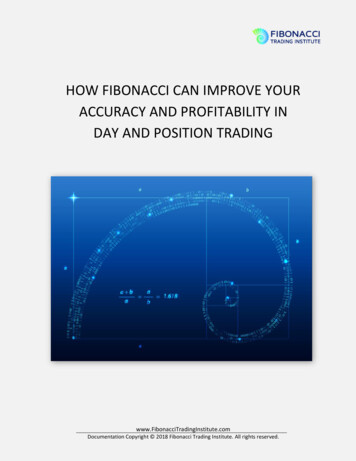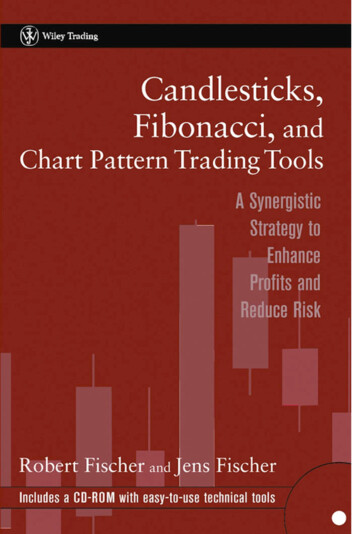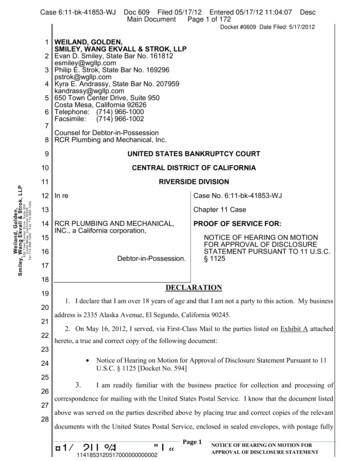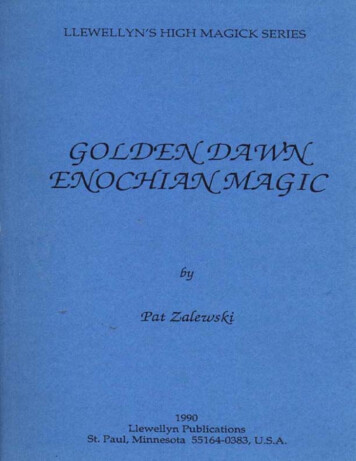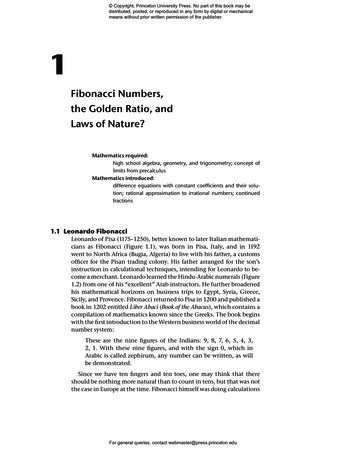
Transcription
Copyright, Princeton University Press. No part of this book may bedistributed, posted, or reproduced in any form by digital or mechanicalmeans without prior written permission of the publisher.1Fibonacci Numbers,the Golden Ratio, andLaws of Nature?Mathematics required:high school algebra, geometry, and trigonometry; concept oflimits from precalculusMathematics introduced:difference equations with constant coefficients and their solution; rational approximation to irrational numbers; continuedfractions1.1 Leonardo FibonacciLeonardo of Pisa (1175–1250), better known to later Italian mathematicians as Fibonacci (Figure 1.1), was born in Pisa, Italy, and in 1192went to North Africa (Bugia, Algeria) to live with his father, a customsofficer for the Pisan trading colony. His father arranged for the son’sinstruction in calculational techniques, intending for Leonardo to become a merchant. Leonardo learned the Hindu-Arabic numerals (Figure1.2) from one of his “excellent” Arab instructors. He further broadenedhis mathematical horizons on business trips to Egypt, Syria, Greece,Sicily, and Provence. Fibonacci returned to Pisa in 1200 and published abook in 1202 entitled Liber Abaci (Book of the Abacus), which contains acompilation of mathematics known since the Greeks. The book beginswith the first introduction to the Western business world of the decimalnumber system:These are the nine figures of the Indians: 9, 8, 7, 6, 5, 4, 3,2, 1. With these nine figures, and with the sign 0, which inArabic is called zephirum, any number can be written, as willbe demonstrated.Since we have ten fingers and ten toes, one may think that thereshould be nothing more natural than to count in tens, but that was notthe case in Europe at the time. Fibonacci himself was doing calculationsFor general queries, contact webmaster@press.princeton.edu
Copyright, Princeton University Press. No part of this book may bedistributed, posted, or reproduced in any form by digital or mechanicalmeans without prior written permission of the publisher.2Chapter 1. Fibonacci NumbersFigure 1.1. Statue of Fibonacci in a cemetery in Pisa. (Photograph by Chris Tung.)Figure 1.2. The Hindu-Arabic numerals.using the Babylonian system of base 60! (It is not as strange as itseems; the remnant of the sexagesimal system can still be found in ourmeasures of angles and time.)The third section of Liber Abaci contains a puzzle:A certain man put a pair of rabbits in a place surrounded on allsides by a wall. How many pairs of rabbits can be produced fromthat pair in a year if it is supposed that each month each pairbegets a new pair which from the second month on becomesproductive?For general queries, contact webmaster@press.princeton.edu
Copyright, Princeton University Press. No part of this book may bedistributed, posted, or reproduced in any form by digital or mechanicalmeans without prior written permission of the publisher.31.1 Leonardo Fibonacci1385321BranchesFigure 1.3. Branching of plant every month after a shoot is two months old.In solving this problem, a sequence of numbers, 1, 1, 2, 3, 5, 8, 13, 21,34, 55, . . . , emerges, as we will show in a moment. This sequence is nowknown as the Fibonacci sequence.The above problem involving incestuous rabbits is admittedly unrealistic, but similar problems can be phrased in more plausible contexts:A plant (tree) has to grow two months before it branches, and then itbranches every month. The new shoot also has to grow for two monthsbefore it branches (see Figure 1.3). The number of branches, includingthe original trunk, is, if one counts from the bottom in intervals of onemonth’s growth: 1, 1, 2, 3, 5, 8, 13, . . . . The plant Achillea ptarmica, the“sneezewort,” is observed to grow in this pattern.The Fibonacci sequence also appears in the family tree of honey bees.The male bee, called the drone, develops from the unfertilized egg ofthe queen bee. Other than the queen, female bees do not reproduce.They are the worker bees. Female bees are produced when the queenmates with the drones. The queen bee develops when a female bee isfed the royal jelly, a special form of honey. So a male bee has only oneparent, a mother, while a female bee, be it the queen or a worker bee,has both a mother and a father. If we count the number of parents andgrandparents and great grandparents, etc., of a male bee, we will get1, 1, 2, 3, 5, 8, . . . , a Fibonacci sequence.Let’s return to the original mathematical problem posed byFibonacci, which we haven’t yet quite solved. We actually want to solveit more generally, to find the number of pairs of rabbits n monthsafter the first pair was introduced. Let this quantity be denoted by Fn .For general queries, contact webmaster@press.princeton.edu
Copyright, Princeton University Press. No part of this book may bedistributed, posted, or reproduced in any form by digital or mechanicalmeans without prior written permission of the publisher.4Chapter 1. Fibonacci NumbersMonth 0:F 0 1Month 1:F1 1Month 2:F2 2Month 3:F3 3F4 5Month 4:Figure 1.4. Rabbits in the Fibonacci puzzle. The small rabbits arenonproductive; the large rabbits are productive.We assume that the initial pair of rabbits is one month old and that wecount rabbits just before newborns arrive.One way to proceed is simply to enumerate, thus generating a sequence of numbers. Once we have a sufficiently long sequence, wewould hopefully be able to see the now famous Fibonacci pattern(Figure 1.4).After one month, the first pair becomes two months old and isready to reproduce, but the census is taken before the birth. So F1 1,but F2 2; by the time they are counted, the newborns are alreadyone month old. The parents are ready to give birth again, but theone-month-old offspring are too young to reproduce. Thus F3 3.At the end of three months, both the original pair and its offspringare productive, although the births are counted in the next period.Thus F4 5. A month later, an additional pair becomes productive.The three productive pairs add three new pairs of offspring to thepopulation. Thus F5 8. At five months, there are five productive pairs:the first-generation parents, four second-generation adults, and onethird-generation pair born in the second month. Thus F6 13. It nowgets more difficult to keep track of all the rabbits, but one can usethe aid of a table to keep account of the ages of the offspring. Withsome difficulty, we obtain the following sequence for the number ofrabbit pairs after n months, for n 0, 1, 2, 3, 4, 5, 6, 7, 8, 9, 10, 11, 12, . . . :1, 1, 2, 3, 5, 8, 13, 21, 34, 55, 89, 144, 233, 377, . . . .For general queries, contact webmaster@press.princeton.edu
Copyright, Princeton University Press. No part of this book may bedistributed, posted, or reproduced in any form by digital or mechanicalmeans without prior written permission of the publisher.51.1 Leonardo FibonacciThis is the sequence first generated by Fibonacci. The answer to hisoriginal question is F12 233.If we had decided to count rabbits after the newborns arrive insteadof before, we would have to deal with three types of rabbits: newborns,one-month-olds, and mature (two-month-old or older) rabbits. In thiscase, the Fibonacci sequence would have shifted by one, to: 1, 2, 3,5, 8, 13, 21, 34, 55, 89, 144, 233, . . . . The initial 1 is missing, which,however, can be added back if we assume that the first pair introducedis newborn. It then takes two months for them to become productive.The discussion below works with either convention.To find Fn for a general positive integer n, we hope that we can see apattern in the sequence of numbers already found. A sharp eye can nowdetect that any number in the sequence is always the sum of the twonumbers preceding it. That is,Fn 2 Fn 1 Fn,for n 0, 1, 2, 3, . . . .(1.1)A second way of arriving at the same recurrence relationship is morepreferable, because it does not depend on our ability to detect a patternfrom a partial list of answers:Let Fn(k) be the number of k-month-old rabbit pairs at time n. Thesewill become (k 1)-month-olds at time n 1. So,Fn 1 (k 1) Fn (k).The total number of pairs at time n 2 is equal to the number at n 1plus the newborn pairs at n 2:Fn 2 Fn 1 new births at time n 2.The number of new births at n 2 is equal to the number of pairs thatare at least one month old at n 1, and so:New births at n 2 Fn 1 (1) Fn 1 (2) Fn 1 (3) Fn 1 (4) · · · Fn(0) Fn(1) Fn(2) Fn(3) · · · Fn.Therefore,Fn 2 Fn 1 Fn,which is the same as Eq. (1.1). This recurrence equation is also calledthe renewal equation. It uses present and past information to predictthe future. Mathematically it is a second-order difference equation.For general queries, contact webmaster@press.princeton.edu
Copyright, Princeton University Press. No part of this book may bedistributed, posted, or reproduced in any form by digital or mechanicalmeans without prior written permission of the publisher.6Chapter 1. Fibonacci NumbersTo solve Eq. (1.1), we try, as we generally do for linear differenceequations whose coefficients do not depend on n,F n λn ,for some as yet undetermined constant λ. When we substitute the trialsolution into Eq. (1.1), we getλn 2 λn 1 λn.Canceling out λn, we obtain a quadratic equation,λ2 λ 1,(1.2)which has two roots (solutions):λ1 111(1 5) and λ2 (1 5) .22λ1Thus λn1 is a solution, and so is λn2 . By the principle of linear superposition, the general solution isFn aλn1 bλn2 ,(1.3)where a and b are arbitrary constants. If you have doubts on the validityof the superposition principle used, I encourage you to plug this generalsolution back into Eq. (1.1) and see that it satisfies that equation nomatter what values of a and b you use. Of course these constants needto be determined by the initial conditions. We need two such auxiliaryconditions since we have two unknown constants. They are F0 1 andF1 1. The first requires that a b 1, and the second implies thatλ1 a λ2 b 1. Together, they uniquely determine the two constants.Finally, we find:1Fn 5 n 1 n 111 51 5 , n 0, 1, 2, 3, . . . .225With the irrational number (1.4)5 in the expression, it is surprising thatEq. (1.4) would always yield whole numbers, 1, 1, 2, 3, 5, 8, 13, . . . , whenn goes from 0, 1, 2, 3, 4, 5, . . . , but you can verify that amazingly it does.For general queries, contact webmaster@press.princeton.edu
Copyright, Princeton University Press. No part of this book may bedistributed, posted, or reproduced in any form by digital or mechanicalmeans without prior written permission of the publisher.71.2 The Golden Ratio1.2 The Golden Ratio The number λ1 12 1 5 is known as the Golden Ratio. It has alsobeen called the Golden Section (in an 1835 book by Martin Ohm) and,since the 16th century, the Divine Proportion. It is thought to reflect theideal proportions of nature and to even possess some mystical powers.It is an irrational number, now denoted by the Greek symbol : 1.6180339887 . . . .It does have some very special, though not so mysterious, properties.For example, its square, 2 2.6180339887 . . . ,is obtainable by adding 1 to . Its reciprocal,1/ 0.6180339887 . . . ,is the same as subtracting 1 from . These properties are not mysteriousat all, if we recall that is a solution of Eq. (1.2).In terms of , the general solution (1.3) can be written as 1Fn a b n n.Since 1, the second term diminishes in importance as n increases,so that for n 1,Fn a n .Therefore the ratio of successive terms in the Fibonacci sequence approaches the Golden Ratio:a n 1Fn 1 1.6180339887 . . . , as n .Fna n(1.5)(In fact, since this property about the ratio converging to the GoldenRatio is independent of a and b, as long as a is not zero, it is satisfied by allsolutions to the difference equation (1.1), including the Lucas sequence,which is the sequence of numbers starting with F0 2 and F1 1: 2, 1,3, 4, 7, 11, 18, 29, . . . ).For general queries, contact webmaster@press.princeton.edu
Copyright, Princeton University Press. No part of this book may bedistributed, posted, or reproduced in any form by digital or mechanicalmeans without prior written permission of the publisher.8Chapter 1. Fibonacci NumbersFor our later use, we also list the resulta n 2Fn 2 2 .Fna n(1.6)As you may recall, an irrational number is a number that cannot beexpressed as the ratio m/n of two integers, m and n. Mathematicianssometimes are interested in the rational approximation of an irrationalnumber; that is, finding two integers, m and n, whose ratio, m/n, gives agood approximation of the irrational number with an error that is assmall as possible under some constraints. For example, the irrationalnumber π 3.14159265 . . . can be approximated by the ratio 22/7 3.142857 . . . , with error 0.00126. This is the best rational approximation if n is to be less than 10. When we make m and n larger, the errorgoes down rapidly. For example, 355/113 is a rational approximationof π (with n less than 200) with an error of 0.000000266. We measurethe degree of irrationality of an irrational number by how slowly theerror of its best rational approximation approaches zero when we allowm and n to get bigger and bigger. In this sense π is “not too irrational.”From Eq. (1.5) we see that the value of can thus be approximated by the rational ratio: 8/5 1.6, or 13/8 1.625, or 21/13 1.615385 . . . , or 34/21 1.619048 . . . , or 55/34 1.617647 . . . , or89/55 1.618182 . . . , or 144/89 1.617978 . . . . The ratios of successive terms in the Fibonacci sequence will eventually converge to theGolden Ratio. One therefore can use the ratio of successive Fibonaccinumbers as the rational approximation to the Golden Ratio. Suchrational ratios, however, converge to the Golden Ratio extremely slowly.Thus we might say that the Golden Ratio is the most irration
been called the Golden Section (in an 1835 book by Martin Ohm) and, since the 16th century, the Divine Proportion. It is thought to reflect the ideal proportions of nature and to even possess some mystical powers. Itisanirrationalnumber,nowdenotedbytheGreeksymbol: 1.6180339887. It does have some very special, though not so mysterious .
